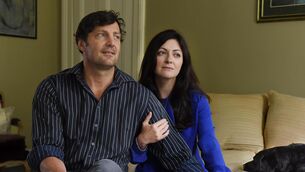Da Vinci lends a hand in birth of lucky Lucy
Baby Lucy O’Mahony’s long-awaited arrival at Cork University Maternity Hospital (CUMH) yesterday brought an end to a very difficult and stressful 18 months for her parents, Anne and Patrick.
But it also gives hope to thousands of Irish women who have lost babies because of a common condition.
Anne, 33, and Patrick, 35, from Donoughmore in Co Cork faced tragedy last year when they lost baby Dylan, five months into Anne’s first pregnancy.
Anne was subsequently diagnosed with a weak cervix — a common condition which occurs in about one in every 100 pregnancies and which causes the cervix to start to open before the baby is ready to be born.
Traditionally, surgeons had to open a woman’s abdomen to insert a special stitch in the cervix in an effort to prolong pregnancy.
It was an invasive procedure which required a four- to five-day hospital stay, along with a three- to four-month recovery period.
However, when Anne became pregnant again late last year, Dr Barry O’Reilly, a consultant in obstetrics and gynaecology at CUMH, suggested using the revolutionary €2 million da Vinci Surgical System to insert the stitch.
He sat at a console and used the robot’s 3D screen to control da Vinci’s four robotic arms in a minimally invasive keyhole surgery procedure.
The surgical instruments are attached to the robotic arms and controlled remotely by the surgeon who sits at the console near the patient.
The robotic arms allow a full 360-degree rotation and eliminate the natural tremor in the hands of the surgeon.
Anne, an accountant, was treated as a day patient and was discharged from hospital within hours. She was back at work within days.
Her pregnancy continued without incident and ended yesterday with Lucy’s birth. The young couple is facing months of night-time feeds and countless nappy changes, but both said they are really looking forward to it.
Anne said Dr O’Reilly’s suggestion to use the da Vinci procedure gave her hope when she needed it most.
“It was unfortunate to lose Dylan. He will always be our first,” Anne said.
“But we were blessed they had this procedure. I was still worried through-out the pregnancy with Lucy that it wouldn’t be successful, but now we’re relieved that it’s all worked out well.
“I was surprised she was a girl because we were convinced she was going to be a boy,” Anne admitted.
As a swaddled Lucy, cradled in her mother’s arms, clasped her father’s right index finger in CUMH yesterday, Patrick said words couldn’t describe his feelings.
“We were always that little bit nervous after what happened last year but we knew we were in safe hands,” he said.
Dr O’Reilly said the da Vinci technology is the way of the future.
“The system benefits patients because it involves less pain and scarring, reduced risk of infection, reduced blood loss and fewer transfusions, quicker recovery time, discharge from hospital and return to normal activities,” he said.
CUMH established its Gynaecological Robotic programme in 2008 after performing the first robotic gynaecological surgery in Britain or Ireland in 2007.
Earlier this year, CUMH, under the direction of Dr O’Reilly and obstetrician Dr Matt Hewitt, who specialises in gynaecological oncology, was designated the first European Robotic Gynaecological Epicentre.
There are three other such centres in Europe, but CUMH is the only one to perform both cancer and non-cancer procedures using sophisticated robotics.
The robotic system, named after the famous Renaissance painter and inventor, enables surgeons to perform complex surgery using a minimally invasive approach.
The system uses up to four arms and flexible wrists, on which are mounted miniaturised tools and cameras controlled by the surgeon sitting at a console.
The surgeon views the surgical field on a hi-res 3D viewer.
Operating through a few small incisions, the surgeon uses controls to manoeuvre the robotic arms.
The hi-tech system is used mostly for hysterectomies, fibroid removal and other gynaecological procedures, but it has since been used recently for heart valve replacements, along with kidney and prostate surgery.
One of the most successful robotic procedures deals with female prolapse, a condition where organs, such as the uterus, fall down or slip out of place.













